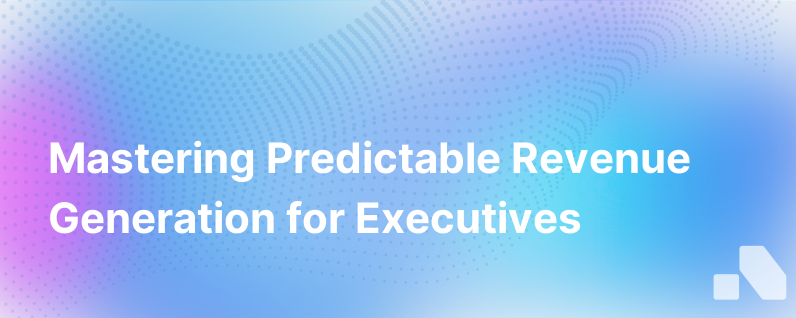
Generating predictable revenue is the holy grail for any business, but particularly for those in the B2B space where sales cycles can be lengthy and complex. Predictability allows businesses to make informed decisions about investments, resources, and growth strategies. Rather than leaving revenue to chance, a systematic approach to sales and marketing can transform the sporadic success into a reliable stream.
In this deep dive, we will explore key strategies to lay a solid foundation for generating predictable revenue. From aligning your teams to leveraging data and technology, these concepts form the pillars of sustainability in business income.
Understanding Predictable Revenue
Predictable revenue is the ability to reliably forecast income over a given period, based on data-driven insights and a consistent sales process. It is the result of an orchestrated effort to standardize and repeat successful practices across the sales and marketing functions.
Having a predictable flow of revenue can significantly reduce the stress that comes with the uncertainty of deal closures and can lead to:
- Better financial planning and budgeting
- More effective allocation of resources
- Improved investor confidence
- Greater overall company stability
Aligning Sales and Marketing
First and foremost, it's essential for sales and marketing to operate in concert. Alignment starts with common goals, shared metrics, and regular communication.
- Common Goals: Sales and marketing teams should work towards unified objectives, such as revenue targets or a specific number of qualified leads.
- Shared Metrics: Both departments should measure progress using the same KPIs, ensuring that they are contributing equitably to the revenue stream.
- Regular Communication: Scheduled meetings for cross-departmental collaboration, updates, and strategy alignment are crucial.
Creating a Scalable Sales Process
A well-defined sales process creates a blueprint for your sales team to follow. It should outline each step from prospecting to closing deals. Review and refine this process regularly to ensure it scales with your business and incorporates best practices and efficient methodologies.
Implementing a Customer Relationship Management (CRM) System
A CRM tool is non-negotiable for predictable revenue. It centralizes customer information, streamlines the sales process, and provides valuable insights through data analysis. With a CRM, forecasting becomes more accurate as historical data can predict future trends with higher precision.
Make sure your CRM:
- Is widely adopted within the company
- Receives regular, clean data inputs
- Produces reports that inform decision-making
Leveraging Data and Analytics
Data is the lifeblood of predictable revenue. Analytics provide the ability to understand what has happened, predict what could happen, and prescribe actions to reach desired outcomes. Utilizing predictive analytics tools can give you the foresight to drive revenue proactively.
- Predictive modeling: Use historical sales data to forecast future performance.
- Conversion rate analysis: Understand at what rate prospects move through the sales funnel and identify areas for optimization.
- Customer lifetime value (CLV): Measure this to focus efforts on attracting and retaining high-value clients.
Nurturing Leads and Relationships
Building a relationship with potential clients through lead nurturing campaigns can turn cold leads into warm, sales-ready prospects. This not only increases the chance of closing a deal but also contributes to predictability in your sales funnel.
Content marketing, email drip campaigns, and targeted social media advertising are effective lead nurturing techniques. Always provide value and maintain engagement to keep your brand top of mind.
Focusing on Customer Success
The journey doesn't end with a successful sale. Building long-lasting customer relationships through exceptional service contributes to predictable revenue by promoting retention and creating opportunities for upselling and cross-selling.
Invest in a robust customer success team that:
- Onboards new clients effectively
- Provides ongoing support and education
- Proactively identifies and addresses potential issues
Establishing Recurring Revenue Streams
A critical aspect of predictability is recurring revenue models, such as subscriptions or retainer services. This can stabilize cash flow and build a base from which to expand.
- Subscription Models: Software as a Service (SaaS) or platform subscriptions can offer a consistent revenue basis.
- Service Retainers: For consultancies or agencies, monthly retainers ensure a steady income while providing ongoing service to clients.
Driving Organizational Discipline
Generating predictable revenue isn't solely about strategies and tactics—it's also about fostering a culture of discipline. Everyone from the C-suite to the sales floors needs to commit to the processes, tools, and systems that enable predictability.
Regular training, performance tracking, and reinforcing the importance of CRM and data hygiene are all part of instilling this discipline.
Utilizing Sales Technology
Sales technology, particularly AI and machine learning tools, can assist in identifying patterns, automating routine tasks, and providing actionable insights to sales representatives. Platforms like Aomni can offer advanced capabilities to harness vast data sets for precise targeting and sales forecasting.
Investing in such tools can multiply the effectiveness of your existing strategies, supercharging your path to predictable revenue.
Conclusion
Generating predictable revenue is a complex, multifaceted endeavor that hinges on strategic alignment, scalable processes, data insights, and a culture of discipline. By systematically implementing the approaches outlined above, businesses can transition from uncertainty to a state of predictable success, which is critical for long-term stability and growth.
When companies apply these principles diligently and leverage the technologies available, such as sophisticated CRMs and platforms like Aomni, they move closer to the coveted predictable revenue model, laying a foundation for sustainable business scaling and robust financial health.